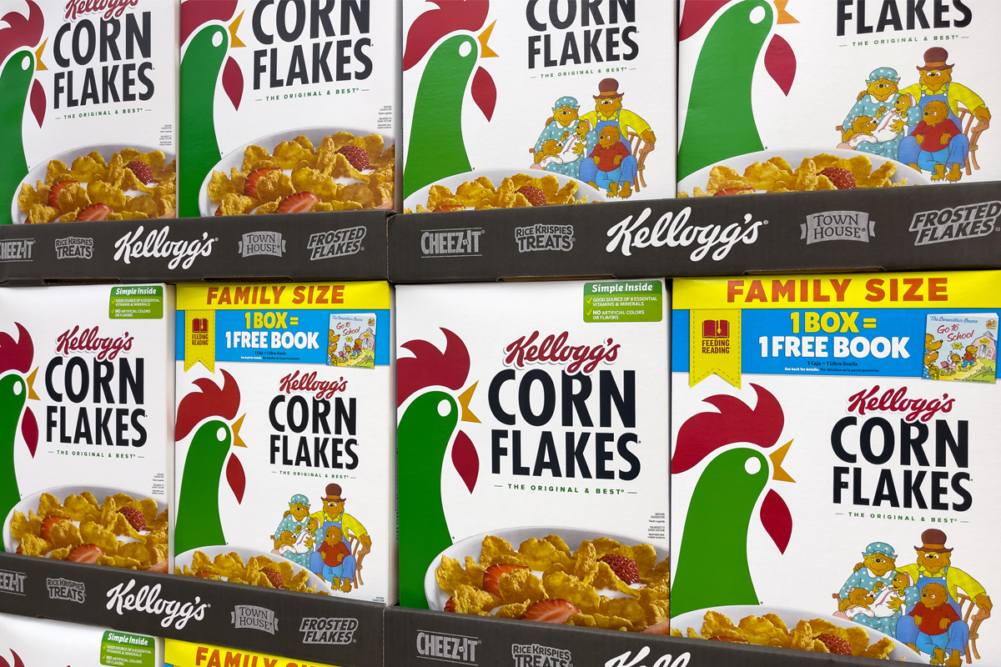BATTLE CREEK, MICH. — Ripple effects from a 12-week strike in 2021 will continue to pose challenges for Kellogg Co. in 2022, especially in the first half of the year, according to the company’s guidance. While the work stoppage took a toll on the company’s business in the second half of 2021, Kellogg still managed to hit its financial guidance for the full year.
In the 12 months ended Jan. 1, Kellogg net income was $1.49 billion, or $4.36 per share on the common stock, up 19% from $1.25 billion, or $3.65 per share, in 2020. Net sales were $14.2 billion, up 2.9% from $13.8 billion.
For the year, organic net sales were up 3.5%, adjusted operating profit fell 1.9% and adjusted earnings per share were up 1.3%. Each of the metrics met or was better than the company’s guidance.
“Facing significant cost inflation, worldwide bottlenecks and shortages, and even a labor strike at all of our US cereal facilities in the fourth quarter, the team executed with agility to deliver another year of on-guidance results,” said Steven A. Cahillane, chairman and chief executive officer of Kellogg.
Results would have been far better in 2021 but for struggles experienced in the North American market. Operating profit in North America was $1.33 billion, down 10% from a year earlier. By contrast, operating profit was up 16% in Europe, 13% in Latin America and 22% in Asia, the Middle East and Africa. In 2021, North America accounted for 76% of the company’s operating profit (which totaled $1.75 billion) and 59% of sales.
“Kellogg North America’s reported operating profit decreased 10% reflecting high cost inflation, economy-wide bottlenecks and shortages, the labor strike, the lapping of an extra shipping week in the year-ago quarter, and higher restructuring charges,” Kellogg said of its full-year results.
In the fourth quarter, the North American business saw a 3% sales decline mostly because of the strike. Mitigating the impact was strong price/mix growth, momentum in snacks and better sales in the away-from home channels. Operating profit tumbled 20%, reflecting the same forces dragging down profits for the year.
During a Feb. 10 conference call with investment analysts, the strength of the company’s snack brands was emphasized by Mr. Cahillane. He said Pringles was closing in on $900 million in US retail sales. The brand’s two-year annual compound growth (CAGR) was 21% in the fourth quarter and 13% for the full year. Cheez-It growth was 9% and 6%, respectively. Pop Tarts enjoyed 11% growth in the fourth quarter (two-year CAGR) and 4% for the year while Rice Krispies Treats jumped 13% in the fourth quarter and 9% for the year.
The strike was the topic of considerable discussion during the conference call.
“We are pleased to have our team back to work,” Mr. Cahillane said. “Strikes are painful for everyone, and not only did this strike affect our employees’ lives. It also had a near-term financial impact on the company. It negatively impacted sales and profit in the fourth quarter of 2021, and it will have carryover cost impact in (the first quarter) of 2022. It will also have sales impacts in the second quarter as we continue to rebuild inventories. In the end, though, we did what we believe was right for the business over the long term.”
Over the near term the strike took a toll. Cereal sales were down 14% in 2021, and the two-year CAGR was a minus 4%, meaning that sales were below pre-pandemic levels. Mr. Cahillane said the company’s problems were compounded by pandemic-related delays the company experienced in planned plant capacity expansions, even before the fire and the strike, the latter which spanned nearly the entire fourth quarter.
“The result of not being able to ship enough product and the related reduction in commercial support for these products was a sharp year-on-year decline in net sales,” he said. “This was mostly in the second half. In fact, through the first half, our two-year CAGR for this business was roughly flat. Unfortunately, this has resulted in low inventories and even out of stocks in stores for many of our brands. And we, therefore, elected to pull back on commercial activity. Not only have we had to pull back on A&P investment, we’ve also had to dramatically reduce our in-store merchandising.”
In its initial guidance for 2022, Kellogg projected growth “in spite of continued economy-wide supply challenges, the residual impact of the US cereal labor strike and fire and further acceleration in cost inflation.” For the year, Kellogg is projecting net sales growth of about 3%, driven by price/mix growth rather than volume; adjusted operating profit growth between 1% and 2%; and adjusted earnings per share growth of 1% to 2%.
Assumptions embedded in the guidance include double-digit cost inflation for the year, higher in the first half than the second; bottlenecks and shortages persisting through mid-year and then moderating in the second half; higher first-quarter costs because of the strike and reduced first-quarter inventory; and a continued deceleration of at-home demand growth and a gradual increase in price elasticity.
While many companies in their guidance suggest one half of the year will be stronger or weaker than the other, Kellogg said the difference in its halves may be particularly pronounced in 2022. Specifically, Kellogg expects weak results in the first half of the year because it will be lapping strong results in the first half of 2021, cost inflation will be the highest, bottlenecks and shortages will be worst and the impact of the 2021 strike and fire will continue to be felt.
Causes for optimism regarding the second half include lapping the strike and fire impacts, lapping the acceleration of input cost inflation and a moderating of bottlenecks and shortages.
In the fourth quarter, Kellogg net income was $433 million, or $1.27 per share, up 111% from $205 million, or 60¢. Sales were $3.42 billion, down 1.2% from $3.46 billion.





